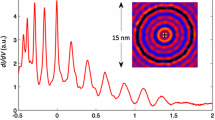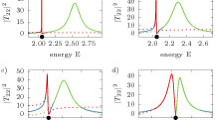Abstract
I met Manuel Cardona for the first time at New York University (NYU) where I was a postdoc of J.L. Birman. At that time J.L. Birman was interested, besides of other topics, in the microscopic theory of resonant Raman scattering and the problem of additional boundary conditions in polariton theory.
Access provided by Autonomous University of Puebla. Download chapter PDF
Similar content being viewed by others
Keywords
These keywords were added by machine and not by the authors. This process is experimental and the keywords may be updated as the learning algorithm improves.
I met Manuel Cardona for the first time at New York University (NYU) where I was a postdoc of J.L. Birman. At that time J.L. Birman was interested, besides of other topics, in the microscopic theory of resonant Raman scattering and the problem of additional boundary conditions in polariton theory.
Manuel told me that he will accept an offer for a directorship at the Max-Planck-Institut für Festkörperforschung in Stuttgart. On invitation of H. Bilz I also planned to go to this institute after my postdoctoral time at NYU and thus hoped for interesting discussions and collaboration with Manuel. I did not become disappointed and had over many years fruitful discussions on many different topics in solid state physics, such as, Raman and Brillouin scattering, electronic band stucture, the electron-phonon coupling and high-Tc superconductors. In the following I will describe two projects in inelastic light scattering in more detail, where we closely interacted with each other.
During my postdoc time in New York J.L. Birman got an invitation to write a review article on light scattering. During writing we became aware of an obvious shortcoming of the microscopic, fully quantized theory of light scattering in extended solids. This theory predicted for the intensity of the scattered light an explicit dependence of ω′/ω (ω and ω′ are the incident and scattered frequencies of the light, respectively). On the other hand it was known from light scattering from molecules and the semiclassical theory in solids that the cross section should obey a ω′3 ω law. We could not find a solution to this problem so it went out of our focus. A few years later I told Manuel of this problem and he immediately engaged himself to find a solution. After several unsuccessful trials (at one time, we suspected that the gauge invariance may be violated in the microscopic theory) we found a way to re-express the microscopic expression for the cross section in such a way that the ω′3ω pre-factor appeared explicitly. The key to this was the derivation of a f-sum rule for displaced atomic positions and then to expand the resonant and non-resonant Raman contributions in terms of atomic displacements. As a result the infinite sum over conduction bands was re-summed yielding a fast convergent series plus an explicit ω′3ω pre-factor. With Manuel’s help I could convince the second author of our SSC letter [1] of the correctness of our explanation. I also was impressed by Manuel doing all the algebra by himself independently from my calculation. At the end we had just to compare the results and were then sure that the calculation was correct.
A deeper and still controversial problem is the so-called additional boundary problem. It arises in polariton theory where the exact eigenmodes (polaritons) of the coupled exciton-photon Hamiltonian are considered. One obtains two dispersive, collective branches. The lower branch increases linearly with momentum well below the exciton, like usual light, and approaches with increasing frequency and momentum the exciton branch from below. The lower polariton branch thus consists mainly of a photon part at small momenta and of an exciton part at large momenta. The second branch starts a zero momentum a little above the exciton energy and approaches towards higher frequencies the straight line of high-frequency photons. For incident light below the exciton only the lower polariton branch can be excited and the boundary conditions from Maxwell’s equations are sufficient to determine the amplitudes of the reflected electric field and of the polarization wave inside the medium. If the frequency of the incident light is larger than the exciton energy both polariton branches may be excited because momentum conservation does not hold at the surface. In this case Maxwell’s boundary conditions are not sufficient to determine all amplitudes and one needs an additional boundary condition (a.b.c.). The incident light thus creates inside the crystal a coherent state with two different polarization waves and the ratio of the polarization waves is determined by the a.b.c. The determination of the a.b.c. has a long and controversial history and even now the problem is not really solved. The underlying difficulty is that the a.b.c. is determined by the way the exciton is exactly reflected at the boundary. Approaching the boundary the exciton as an extended bound state of a hole and an electron gets deformed in a complicated way and ceases to exist very near the boundary. In Ref. [2] it was argued that resonant Brillouin scattering should show in general four and not one peak in the scattered light because of the presence of two polarization waves and that the measured intensities of the lines could be used to determine experimentally the a.b.c. Unfortunately the light scattering experimentalists in New York and also in Stuttgart were very skeptical whether one could detect these predicted lines because they would sit on a huge background of Rayleigh scattering. Actually, these additional lines in Brillouin scattering were found by chance by Ulbrich and Weisbuch in 1977.
Manuel was first also skeptical whether these lines were observable in real systems. But after 1977 he got very interested in this subject, not so much in the controversial a.b.c. problem but in getting information from such experiments on the band structure, exciton masses and the electron-phonon coupling. He recognized that most of this information can be obtained without knowledge of the a.b.c., just from conservation of energy and, inside of the crystal, of momentum. On the other hand the experimental spectra, for instance in CuBr and CdTe, showed many more lines and were much more complex than in our original proposal. Manuel recognized that a more realistic description of the exciton was necessary to explain the spectra. The Hilbert space of exciton states involves two spin states for the electron times 4 spin states of the hole described by a J = 3/2 spin operator. The exciton Hamiltonian in this 8 dimensional space can be expressed by invariants formed from products of the electron spin operator σ, the hole spin operator J, and the center-of-mass wave vector k of the exciton. The prefactor of these invariants represent exciton parameters. Manuel and his coworkers worked out the excitation spectrum of the exciton along the main symmetry direction, calculated the corresponding polariton dispersion curves and determined the exciton parameters by comparing the theoretical predictions with the experimental data. Looking, for instance, at Figs. 4–6 in [3] or Fig. 6 in [4] one is deeply impressed by the careful and clear analysis of the data, the fantastically good agreement between experiment and theory and the clear-cut conclusions achieved in these papers.
References
R. Zeyher, H. Bilz and M. Cardona, Solid State Commun. 19, 57 (1976)
W. Brenig, R. Zeyher, J.L. Birman, Phys. Rev. B 6, 4617 (1972)
D.-P Vu, Y. Oka, M. Cardona, Phys. Rev. B 24, 765 (1981)
J.C. Merle, R. Sooryakumar, M. Cardona, Phys. Rev. B 30, 3261 (1984)
Author information
Authors and Affiliations
Editor information
Editors and Affiliations
Rights and permissions
Copyright information
© 2016 Springer International Publishing Switzerland
About this chapter
Cite this chapter
Zeyher, R. (2016). Interactions of Theory and Experiment in Raman Scattering. In: Ensslin, K., Viña, L. (eds) Manuel Cardona. Springer, Cham. https://doi.org/10.1007/978-3-319-20343-0_44
Download citation
DOI: https://doi.org/10.1007/978-3-319-20343-0_44
Published:
Publisher Name: Springer, Cham
Print ISBN: 978-3-319-20342-3
Online ISBN: 978-3-319-20343-0
eBook Packages: Physics and AstronomyPhysics and Astronomy (R0)




